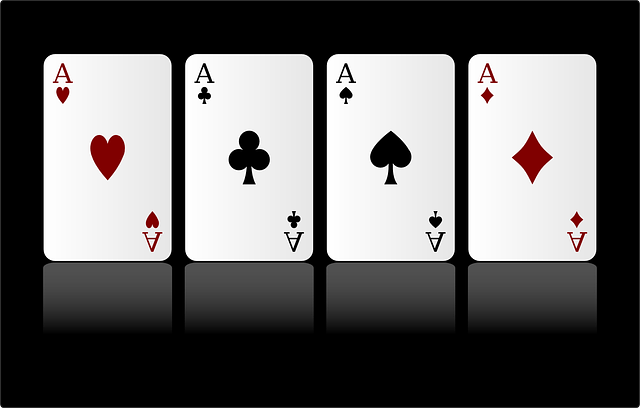
A deck of playing cards is a familiar sight to many, whether used for playing games, performing magic tricks, or simply for decoration. Each card in a deck has a specific value and meaning, but none are as versatile and iconic as the Ace cards. (See also The Ace Card)
In this post, we will delve deeper into what Ace cards are, their history, and what makes them so special.
What are the Ace Cards in a Deck?
The Ace cards are the highest-ranking cards in a standard deck of playing cards. They are commonly abbreviated as “A” and are often depicted as a single large symbol or letter in the center of the card. (See also Is an Ace a Face Card or Number Card?)
The four suits of the Ace cards are clubs, diamonds, hearts, and spades. Each suit has one Ace card, making a total of four Ace cards in a deck. (See How Many Aces are in a Deck of 52 Cards?)

History of the Ace Cards
The Ace cards have a rich history that dates back centuries. The earliest known playing cards appeared in China during the Tang dynasty in the 9th century. They were made of paper and decorated with intricate designs. These early cards were used for games such as chess, but they also had religious and symbolic meanings. The cards spread throughout Asia and eventually made their way to Europe in the 14th century.
The first European playing cards had four suits, which were cups, swords, coins, and batons. The cards were hand-painted and highly detailed, often depicting elaborate scenes and figures. Over time, the suits evolved into the familiar clubs, diamonds, hearts, and spades we know today.
The Ace card has a rich and fascinating history that spans several centuries and multiple cultures. While the origins of the Ace card are somewhat obscure, it is generally believed to have originated in Europe during the Middle Ages, when playing cards first became popular among the nobility and wealthy merchants.
The earliest versions of the Ace card were simple and straightforward, with a single symbol or design indicating its value. Over time, however, the Ace card began to take on more complex and symbolic meanings, reflecting the changing cultural and social contexts in which it was used.
In many European countries, for example, the Ace card came to be associated with royalty and nobility, reflecting the fact that it was often the highest-ranking card in the deck. In France, the Ace card was sometimes referred to as “L’As,” or “The Ace,” a term that is still in use today.
In other parts of the world, the Ace card took on different symbolic meanings. In China and other parts of East Asia, for example, the Ace card was often associated with the number one, reflecting its status as the first card in the deck. In Japan, the Ace card was sometimes depicted as a dragon or other powerful creature, reflecting its importance in games of strategy and skill.
As playing cards spread throughout Europe and eventually around the world, the Ace card became a symbol of many different things, from power and strength to opportunity and potential. It was used in a wide range of games and activities, from simple gambling games to complex strategy games, and its versatility and flexibility made it a popular choice among players of all levels of experience.
Unique Characteristics of the Ace Cards
The Ace cards have several unique characteristics that set them apart from the rest of the deck. First and foremost, they are the highest-ranking cards in the deck, making them incredibly valuable. In most games, the goal is to collect as many high-ranking cards as possible, and the Ace cards are always highly sought after.
Another unique characteristic of the Ace cards is their versatility. Unlike other cards in the deck, the Ace cards can be used to represent both high and low values. For example, in a game of blackjack, an Ace can be worth either 1 or 11, depending on the player’s preference. This versatility makes the Ace cards incredibly valuable in a variety of games and situations.
The Ace cards also have symbolic meanings and associations. In many cultures, the Ace cards are associated with power, authority, and victory. The Ace of Spades, in particular, has a long history of being associated with death and war. During World War II, American soldiers would often leave an Ace of Spades on the bodies of enemy soldiers as a sign of disrespect.
In addition to their symbolic meanings, the Ace cards also have practical uses in games and magic tricks. In many card games, the Ace cards can be used to initiate special actions or bonuses. For example, in the game of Hearts, the player who collects all four Ace cards is awarded bonus points. In magic tricks, Ace cards are often used to create illusions and sleight of hand.
Final Thoughts
The Ace cards are an essential part of any deck of playing cards. They are the highest-ranking cards in the deck, making them incredibly valuable and sought after. Their versatility and symbolism make them unique and iconic, and they have a rich history that dates back centuries.
Whether you’re playing a game of poker, or performing a card trick, the Ace cards are a powerful and essential tool that adds depth and excitement to any activity.
The magician started magic as a kid and has learned from some of the greats. He loves to share his knowledge with others and help out with the subtleties he’s learned along the way.
Follow on YouTube at the link below to get free tricks and advice!


